
Indian removal was the United States government policy of forced displacement of self-governing tribes of Native Americans from their ancestral homelands in the eastern United States to lands west of the Mississippi River – specifically, to a designated Indian Territory. The Indian Removal Act, the key law which authorized the removal of Native tribes, was signed by Andrew Jackson in 1830. Although Jackson took a hard line on Indian removal, the law was enforced primarily during the Martin Van Buren administration. After the passage of the Indian Removal Act in 1830, approximately 60,000 members of the Cherokee, Muscogee (Creek), Seminole, Chickasaw, and Choctaw nations were forcibly removed from their ancestral homelands, with thousands dying during the Trail of Tears.
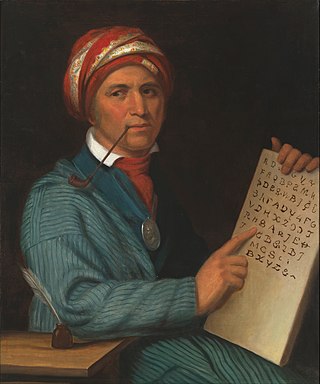
The Cherokee are one of the indigenous peoples of the Southeastern Woodlands of the United States. Prior to the 18th century, they were concentrated in their homelands, in towns along river valleys of what is now southwestern North Carolina, southeastern Tennessee, southwestern Virginia, edges of western South Carolina, northern Georgia, and northeastern Alabama.
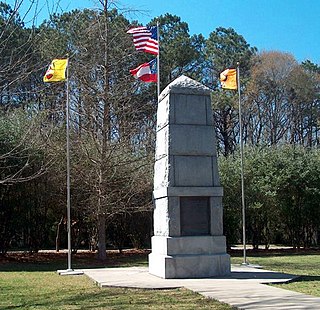
The Trail of Tears was an ethnic cleansing and forced displacement of approximately 60,000 people of the "Five Civilized Tribes" between 1830 and 1850 by the United States government. As part of the Indian removal, members of the Cherokee, Muscogee (Creek), Seminole, Chickasaw, and Choctaw nations were forcibly removed from their ancestral homelands in the Southeastern United States to newly designated Indian Territory west of the Mississippi River after the passage of the Indian Removal Act in 1830. The Cherokee removal in 1838 was brought on by the discovery of gold near Dahlonega, Georgia, in 1828, resulting in the Georgia Gold Rush.

The term Five Civilized Tribes was applied by European Americans in the colonial and early federal period in the history of the United States to the five major Native American nations in the Southeast—the Cherokee, Chickasaw, Choctaw, Muscogee, and Seminoles. Americans of European descent classified them as "civilized" because they had adopted attributes of the Anglo-American culture. Examples of such colonial attributes adopted by these five tribes included Christianity, centralized governments, literacy, market participation, written constitutions, intermarriage with white Americans, and chattel slavery practices, including purchase of enslaved African Americans. For a period, the Five Civilized Tribes tended to maintain stable political relations with the European Americans, before the United States promoted Indian removal of these tribes from the Southeast.

The Indian Removal Act was signed into law on May 28, 1830, by United States President Andrew Jackson. The law, as described by Congress, provided "for an exchange of lands with the Indians residing in any of the states or territories, and for their removal west of the river Mississippi." During the Presidency of Jackson (1829–1837) and his successor Martin Van Buren (1837–1841) more than 60,000 Indians from at least 18 tribes were forced to move west of the Mississippi River where they were allocated new lands as part of an ethnic cleansing. The southern tribes were resettled mostly in Indian Territory (Oklahoma). The northern tribes were resettled initially in Kansas. With a few exceptions, the United States east of the Mississippi and south of the Great Lakes was emptied of its Indian population. The movement westward of the Indian tribes was characterized by a large number of deaths occasioned by the hardships of the journey.

John Ross was the Principal Chief of the Cherokee Nation from 1828 to 1866; he served longer in that position than any other person. Described as the Moses of his people, Ross influenced the nation through such tumultuous events as the relocation to Indian Territory and the American Civil War.

Brigadier-General Stand Watie, also known as Standhope Uwatie, Tawkertawker, and Isaac S. Watie, was a Cherokee politician who served as the second principal chief of the Cherokee Nation from 1862 to 1866. The Cherokee Nation allied with the Confederate States during the American Civil War and he was the only Native American Confederate general officer of the war. Watie commanded Indian forces in the Trans-Mississippi Theater, made up mostly of Cherokee, Muskogee, and Seminole. He was the last Confederate States Army general to surrender.
Cherokee Nation v. Georgia, 30 U.S. 1 (1831), was a United States Supreme Court case. The Cherokee Nation sought a federal injunction against laws passed by the U.S. state of Georgia depriving them of rights within its boundaries, but the Supreme Court did not hear the case on its merits. It ruled that it had no original jurisdiction in the matter, as the Cherokees were a dependent nation, with a relationship to the United States like that of a "ward to its guardian," as said by Chief Justice Marshall.

Major Ridge, The Ridge was a Cherokee leader, a member of the tribal council, and a lawmaker. As a warrior, he fought in the Cherokee–American wars against American frontiersmen. Later, Major Ridge led the Cherokee in alliances with General Andrew Jackson and the United States in the Creek and Seminole wars of the early 19th century.
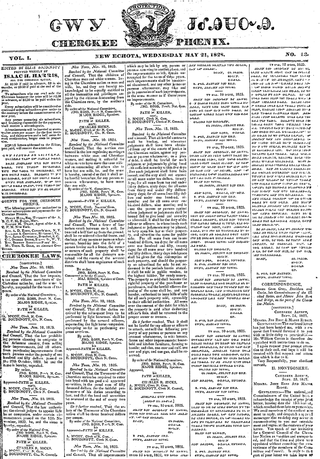
The Cherokee Phoenix is the first newspaper published by Native Americans in the United States and the first published in a Native American language. The first issue was published in English and Cherokee on February 21, 1828, in New Echota, capital of the Cherokee Nation. The paper continued until 1834. The Cherokee Phoenix was revived in the 20th century, and today it publishes both print and Internet versions.

Red Clay State Historic Park is a state park located in southern Bradley County, Tennessee, United States. The park was the site of the last capital of the Cherokee Nation in the eastern United States from 1832 to 1838 before the enforcement of the Indian Removal Act of 1830. This resulted in a forced migration of most of the Cherokee people to present-day Oklahoma known as the Cherokee removal. The site is considered sacred to the Cherokees, and includes the Blue Hole Spring, a large hydrological spring. It is also listed as an interpretive center along the Trail of Tears National Historic Trail.
This is a timeline of events in the history of the Cherokee Nation, from its earliest appearance in historical records to modern court cases in the United States. Some basic content about the removal of other southeastern tribes to lands west of the Mississippi River is included. In a series of treaties, these tribes ceded land to the United States.

The Cherokee in the American Civil War were active in the Trans-Mississippi and Western Theaters. In the east, Confederate Cherokees led by William Holland Thomas hindered Union forces trying to use the Appalachian mountain passes of western North Carolina and eastern Tennessee. Out west, Confederate Cherokee Stand Watie led primarily Native Confederate forces in the Indian Territory, in what is now the state of Oklahoma. The Cherokee partnered with the Confederacy in order to get funds, as well as ultimately full recognition as a sovereign, independent state.
Doublehead (1744–1807) or Incalatanga, was one of the most feared warriors of the Cherokee during the Cherokee–American wars. Following the peace treaty at the Tellico Blockhouse in 1794, he served as one of the leaders of the Chickamauga Cherokee, and he was chosen as the leader of Chickamauga in 1802.

David Vann was a sub-chief of the Cherokee people. He was a skilled negotiator with the United States government on behalf of the Cherokee and Creek peoples. Vann was elected treasurer of the Cherokee Nation in 1839, 1843, 1847 and 1851.
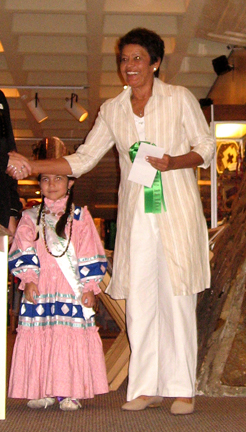
Virginia Alice Stroud is a Cherokee-Muscogee Creek painter from Oklahoma. She is an enrolled member of the United Keetoowah Band of Cherokee Indians.
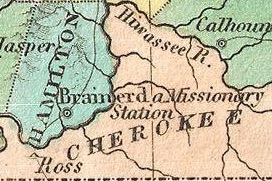
Cherokee removal, part of the Trail of Tears, refers to the forced relocation between 1836 and 1839 of an estimated 16,000 members of the Cherokee Nation and 1,000–2,000 of their slaves; from their lands in Georgia, South Carolina, North Carolina, Tennessee, and Alabama to the Indian Territory in the then Western United States, and the resultant deaths along the way and at the end of the movement of an estimated 4,000 Cherokee and unknown number of slaves, although no records of these deaths have ever materialized. Many scholars believe these Indians absconded from the removal rather than died.
Goingsnake, also spelled Going Snake; in Cherokee, I-na-du-na-i) (Cherokee) was a respected warrior, gifted orator, and prominent political leader of his people. He was born in the vicinity of present-day Nottely Lake, Georgia, then part of the large Cherokee territory.
Maggie Axe Wachacha (1892–1993) was renowned for reinvigorating Cherokee culture and for her work in ethnobotany.
The Hiwassee River Heritage Center is a history museum located in Charleston, Tennessee which was established in 2013. The museum chronicles the region's Cherokee and Civil War history. It is a certified interpretive center on the Trail of Tears National Historic Trail.













